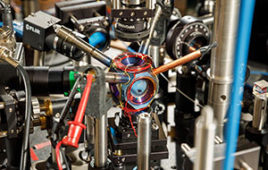Is a new phone on your holiday shopping list? A “radical” technology being developed at Purdue University that’s making smartphones and other electronic devices more bendable could help save lives one day soon through better health monitoring.
The Purdue team has designed a glass-like polymer to conduct electricity for transparent and flexible electronics.
The innovative polymer film, which has the look and feel of glass, can be inexpensively and sustainably produced on a large scale because it originates from earth-abundant materials. Its cost effectiveness also has advantages over polymers already used for electronics that rely on expensive chemistry and chemical doping to achieve high conductivity.
Purdue’s polymer is made out of long chains that contain radical groups, which are molecules that contain at least one unpaired electron.
“We have made a giant leap in polymer production by better matching the mechanical properties of organic materials used to create them and helping to avoid catastrophic failures with electronic display screens,” says Bryan Boudouris, the Robert and Sally Weist Associate Professor of Chemical Engineering, who led the research team.
The team’s work aligns with Purdue’s Giant Leaps celebration, acknowledging the university’s global advancements in health and sustainability as part of Purdue’s 150th anniversary. This is one of the four themes of the yearlong celebration’s Ideas Festival, designed to showcase Purdue as an intellectual center solving real-world issues.
Brett Savoie, an assistant professor of chemical engineering who served as a senior member of the research team, said the new polymer is also the central platform for research at the Purdue-based Materials Innovation for Bioelectronics from Intrinsically stretchable Organics (Mi-Bio) center. The researchers there are working to use this new polymer film to create tailor-made sensors that could non-invasively monitor glucose levels, heart rate or other biomedical metrics.

Purdue University researchers are working to use a new polymer film, which could make smartphones more bendable, to create tailor-made sensors that could non-invasively monitor glucose levels, heart rate or other biomedical metrics. Image: Provided
The Purdue polymer film could be modified, using specific molecules or ions, to target and selectively interact with various biological components inside the body. It could be worn as a nearly invisible patch on the skin.
“It’s incredible to be part of the Purdue team that’s leveraging the enormous chemical flexibility of these materials to create life-saving technology,” Savoie says.
Researchers are working with the Purdue Office of Technology Commercialization to patent the innovation, and they are looking for partners to continue developing it.
Source: Purdue University




